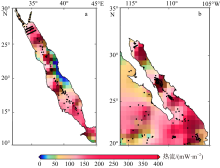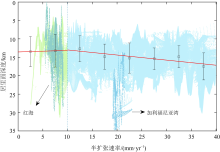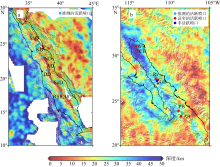热带海洋学报 ›› 2023, Vol. 42 ›› Issue (6): 74-88.doi: 10.11978/2023032CSTR: 32234.14.2023032
红海与加利福尼亚湾初始扩张系统的热状态差异
徐柳娜1( ), 李春峰1,2(
), 李春峰1,2( ), 黄亮1, 朱塽1, 尹义红3
), 黄亮1, 朱塽1, 尹义红3
- 1.浙江大学海洋科学系, 浙江 舟山 316021
2.浙江大学海南研究院, 海南 三亚 572025
3.山东华坤自然资源数字产业集团, 山东 济南 250014
-
收稿日期:2023-03-10修回日期:2023-04-28出版日期:2023-11-10发布日期:2023-11-28 -
作者简介:徐柳娜(1996—), 女, 山东省烟台市人, 硕士研究生, 从事海洋地球物理研究。email: 22034129@zju.edu.cn
-
基金资助:国家自然科学基金项目(91858213); 国家自然科学基金项目(42176055); 海南省自然科学基金(421CXTD441); 舟山市校合作项目(2019C81058)
Contrasting thermal states of the initial spreading systems between the Red Sea and the Gulf of California
XU Liuna1( ), LI Chunfeng1,2(
), LI Chunfeng1,2( ), HUANG Liang1, ZHU Shuang1, YIN Yihong3
), HUANG Liang1, ZHU Shuang1, YIN Yihong3
- 1. Department of Marine Science, Zhejiang University, Zhoushan 316021, China
2. Hainan Institute, Zhejiang University, Sanya 572025, China
3. Shandong Huakun Natural Resources Digital Industry Group, Jinan 250014, China
-
Received:2023-03-10Revised:2023-04-28Online:2023-11-10Published:2023-11-28 -
Supported by:National Natural Science Foundation of China(91858213); National Natural Science Foundation of China(42176055); Natural Science Foundation of Hainan Province, China(421CXTD441); Zhejiang University Cooperation Project with Zhoushan city(2019C81058)
摘要:
红海与加利福尼亚湾同处于由大陆裂谷向初始海底扩张的过渡阶段, 但具有显著不同的构造背景与演化特征。本文基于磁异常数据, 利用基于傅里叶变换和小波变换的质心法, 计算得到了红海和加利福尼亚湾的居里面深度, 对比发现二者热状态存在显著差异, 不同方法的计算结果均显示加利福尼亚湾的居里面明显深于红海的居里面。红海扩张中心相对连续, 岩浆活动较为活跃, 而加利福尼亚湾扩张中心区域广泛发育了错开扩张脊的转换断层, 并且扩张中心处热液活动强烈, 加速了该区域的热对流和热损耗。此外, 扩张速率与热状态和热液活动之间存在着明显的耦合关系。加利福尼亚湾的扩张速率是红海的两倍多, 较快的扩张速率与热液活动正相关, 较强的热液活动加速热损耗而加深居里面, 也是引起加利福尼亚湾居里面比红海居里面深的原因之一。
引用本文
徐柳娜, 李春峰, 黄亮, 朱塽, 尹义红. 红海与加利福尼亚湾初始扩张系统的热状态差异[J]. 热带海洋学报, 2023, 42(6): 74-88.
XU Liuna, LI Chunfeng, HUANG Liang, ZHU Shuang, YIN Yihong. Contrasting thermal states of the initial spreading systems between the Red Sea and the Gulf of California[J]. Journal of Tropical Oceanography, 2023, 42(6): 74-88.

图1
红海区域地形图(a)及加利福尼亚湾区域地形图(b) a中黑色虚线表示红海分段; 红色实线表示红海裂谷轴部; 黑色实线表示断层; 蓝色箭头表示板块相对运动方向。b中红色实线表示加利福尼亚湾南部的扩张段和加利福尼亚湾北部复杂的拉分盆地; 裂谷内黑色实线表示转换断层; 蓝色箭头表示板块相对运动方向。WB: Wagner盆地; CB: Consag盆地; DB: Delfin盆地; TB: Tiburon盆地; AB: Alarcon盆地; PB: Pescadero盆地; FB: Farallon盆地; CB: Carmen盆地; GB: Guaymas盆地。水深数据来自GEBCO Compilation Group (2021)。断层数据来自Styron等(2020)"


图6
基于傅里叶变换计算得到的加利福尼亚湾地区居里面深度图 a. 窗口大小为99.2km×99.2km; b. 窗口大小为148.8km×148.8km; c. 窗口大小为198.4km×198.4km; d. 平均居里面深度。WB: Wagner盆地; CB: Consag盆地; DB: Delfin盆地; TB: Tiburon盆地; AB: Alarcon盆地; PB: Pescadero盆地; FB: Farallon盆地; CB: Carmen盆地; GB: Guaymas盆地。红色实线表示加利福尼亚湾南部的扩张段和加利福尼亚湾北部复杂的拉分盆地。裂谷内黑色实线表示转换断层。粉色虚线BB’表示图8b的剖面位置"

| [1] |
宋珏琛, 李江海, 冯博, 2021. 慢速-超慢速扩张洋中脊热液活动及其机理[J]. 地质学报, 95(8): 2273-2283.
|
|
|
|
| [2] |
徐行, 姚永坚, 彭登, 等, 2018. 南海西南次海盆的地热流特征与分析[J]. 地球物理学报, 61(7): 2915-2925.
|
|
|
|
| [3] |
王淑杰, 翟世奎, 于增慧, 等, 2018. 关于现代海底热液活动系统模式的思考[J]. 地球科学, 43(3): 835-850.
|
|
|
|
| [4] |
doi: 10.3390/su15054549 |
| [5] |
doi: 10.1016/j.jseaes.2016.07.025 |
| [6] |
|
| [7] |
doi: 10.1016/j.proeps.2016.12.139 |
| [8] |
|
| [9] |
doi: 10.1016/j.epsl.2014.03.047 |
| [10] |
doi: 10.1016/j.geomorph.2016.08.028 |
| [11] |
|
| [12] |
doi: 10.1016/j.jvolgeores.2019.03.005 |
| [13] |
doi: 10.1016/j.sedgeo.2010.05.004 |
| [14] |
|
| [15] |
doi: 10.1016/j.apgeochem.2019.104467 |
| [16] |
|
| [17] |
doi: 10.1016/j.jsames.2020.102501 |
| [18] |
doi: 10.1016/0016-7037(96)00099-3 |
| [19] |
|
| [20] |
doi: 10.1029/2018JB016726 |
| [21] |
GEBCO COMPILATION GROUP, 2021. The GEBCO_2021 Grid-A continuous terrain model of the global oceans and land[DB/OL]. Published Data Library (PDL), [2023-03-09]. https://www.bodc.ac.uk/data/published_data_library/catalogue/10.5285/c6612cbe-50b3-0cff-e053-6c86abc09f8f/
|
| [22] |
doi: 10.5194/bg-15-5715-2018 |
| [23] |
doi: 10.1080/00206814.2014.941023 |
| [24] |
doi: 10.3390/en15228634 |
| [25] |
|
| [26] |
doi: 10.1016/j.tecto.2022.229604 |
| [27] |
doi: 10.1130/0016-7606(1972)83[3345:BMAAPT]2.0.CO;2 |
| [28] |
doi: 10.1130/0091-7613(1986)14<651:WAMMAS>2.0.CO;2 |
| [29] |
doi: 10.1016/j.jog.2010.08.003 |
| [30] |
|
| [31] |
doi: 10.1038/s41598-016-0028-x |
| [32] |
doi: 10.1111/j.1365-246X.2010.04702.x |
| [33] |
|
| [34] |
doi: 10.1002/ggge.v14.12 |
| [35] |
doi: 10.1007/s11600-019-00339-6 |
| [36] |
doi: 10.1016/0012-821X(85)90070-6 |
| [37] |
|
| [38] |
doi: 10.1029/2019GC008389 |
| [39] |
|
| [40] |
|
| [41] |
doi: 10.1016/j.epsl.2017.09.037 |
| [42] |
doi: 10.1190/1.1441926 |
| [43] |
|
| [44] |
|
| [45] |
doi: 10.1016/S0016-7037(00)00618-9 |
| [46] |
|
| [47] |
doi: 10.1016/j.isci.2020.101459 |
| [48] |
doi: 10.1016/j.marpetgeo.2021.105253 |
| [49] |
doi: 10.1007/s00024-012-0461-0 |
| [50] |
|
| [51] |
|
| [52] |
|
| [53] |
|
| [54] |
|
| [55] |
doi: 10.1038/205165a0 |
| [56] |
doi: 10.1016/S0040-1951(99)00072-4 |
| [57] |
doi: 10.1038/s41598-019-50200-5 |
| [58] |
|
| [59] |
doi: 10.1016/j.chemgeo.2015.04.001 |
| [60] |
|
| [61] |
doi: 10.1130/GES02082.1 |
| [62] |
doi: 10.1016/S0012-821X(02)01081-6 |
| [63] |
doi: 10.1016/j.tecto.2014.11.002 |
| [64] |
doi: 10.1016/j.gr.2022.09.010 |
| [65] |
doi: 10.1093/gji/ggab257 |
| [66] |
doi: 10.1007/s11001-020-09401-1 |
| [1] | 程皓, 王友绍, 马晓宇. 红海榄幼苗根系呼吸代谢对水淹胁迫的响应[J]. 热带海洋学报, 2022, 41(6): 12-19. |
| [2] | 谢勇, 王友绍, 张维仕. 红海榄肉桂酸-4-羟基化酶基因的克隆与表达分析[J]. 热带海洋学报, 2022, 41(6): 20-27. |
| [3] | 任自强, 施小斌, 王晓芳, 赵鹏, 谌永强. 南海南沙海槽深部热状态及其构造意义[J]. 热带海洋学报, 2021, 40(4): 98-109. |
| [4] | 秦莉真, 张蔚, 官明开, 赵晟, 程梁秋. 不同周期分潮簇对复杂河网潮位分布的影响*[J]. 热带海洋学报, 2019, 38(1): 27-34. |
| [5] | 刘广平, 何伟宏, 邹晓理, 王昭正, 孙天山. 红海湾西北海区海流特征分析[J]. 热带海洋学报, 2018, 37(5): 40-49. |
| [6] | 徐子英, 杨小秋, 施小斌, 曾信, 赵俊峰, 于传海. 探针偏角对海底热流测量结果的影响*[J]. 热带海洋学报, 2016, 35(4): 95-101. |
| [7] | 莫竹承 高忠春, 龙波. 红海榄人工幼苗生长特征研究[J]. 热带海洋学报, 2012, 31(6): 103-106. |
| [8] | 马辉, 许鹤华, 赵俊峰, 万菊英, 陈爱华, 刘唐伟. 南沙海槽前陆盆地热结构*[J]. 热带海洋学报, 2012, 31(3): 155-161. |
| [9] | 赵俊峰,施小斌,丘学林,刘海龄. 南海东北部居里面特征及其石油地质意义[J]. 热带海洋学报, 2010, 29(1): 126-131. |
| [10] | 杨小秋,施小斌,许鹤华,徐行,李官保,郭兴伟,罗贤虎 . 双探针型海底热流计数据解算模型选取[J]. 热带海洋学报, 2009, 28(4): 28-34. |
|
||























